#estimating data integration
Explore tagged Tumblr posts
Text
Top Software Tools Used in a Residential Estimating Service
The construction industry has witnessed significant technological advancements in recent years, and estimating software has played a crucial role in these improvements. For residential projects, accurate cost estimation is vital to ensure that homeowners stay within budget, contractors avoid costly mistakes, and the project proceeds smoothly. Residential estimating services rely on specialized software tools to enhance efficiency, accuracy, and collaboration between all parties involved. Below, we’ll explore some of the top software tools used in residential estimating services and how they streamline the estimation process.
1. Buildertrend
Buildertrend is one of the most popular project management software tools for residential construction. It’s designed to streamline communication, project scheduling, and budgeting, making it an all-in-one tool for contractors and homeowners alike.
Key Features:
Cost estimation and budgeting tools
Real-time updates for project costs and schedules
Change order management and client approvals
Document sharing and communication between stakeholders
Buildertrend allows contractors to create detailed cost estimates and adjust budgets as the project progresses. Homeowners can track expenses, monitor change orders, and ensure that their project stays within financial limits. This software’s flexibility makes it suitable for both small residential builds and larger home improvement projects.
2. ProEst
ProEst is a comprehensive estimating software that provides detailed cost breakdowns and real-time data, enabling contractors and estimators to make precise calculations for residential projects. This tool is popular among residential estimators due to its user-friendly interface and customizable features.
Key Features:
Pre-built cost databases and templates
Integration with other software like QuickBooks and Procore
Customizable project reports
Cloud-based platform for easy access from anywhere
ProEst is particularly beneficial for contractors who handle a variety of residential projects, as it allows them to create accurate, data-driven estimates based on real-time material and labor costs. The software also supports collaborative features, enabling multiple users to work on the same project estimate simultaneously.
3. Clear Estimates
Clear Estimates is a cloud-based software designed specifically for residential estimators. This tool simplifies the process of creating accurate, detailed cost estimates for construction projects by providing access to a large database of material costs and labor rates.
Key Features:
Easy-to-use interface with customizable templates
Material and labor cost databases tailored for residential construction
Automatic pricing updates based on current market data
Integrated reporting and proposal generation tools
Clear Estimates is ideal for contractors who need to produce quick yet accurate estimates for smaller residential projects. Its pre-built templates save time and ensure that estimators do not overlook any key components when calculating costs.
4. RSMeans Data Online
RSMeans is a widely recognized cost estimating software used by contractors and construction professionals to access comprehensive cost data. While it’s commonly used for larger commercial projects, it also provides detailed cost estimates for residential construction projects.
Key Features:
Extensive cost data for materials, labor, and equipment
Market-specific pricing for various regions
Built-in calculators for more accurate estimates
Integration with other software tools for seamless workflow
RSMeans Data Online is ideal for contractors working on larger or more complex residential projects that require detailed cost analysis. It’s particularly valuable for ensuring that all components of a project are priced accurately, including materials, labor, and overhead costs.
5. CostCertified
CostCertified is a relatively new but highly efficient estimating tool designed specifically for residential contractors. It focuses on providing real-time cost estimates, enabling homeowners to make quick decisions based on accurate pricing. This software is particularly popular for home renovations and custom home builds.
Key Features:
Real-time cost updates with vendor pricing
Seamless collaboration with clients through the app
Transparent cost breakdowns, including materials and labor
Detailed reports and change order tracking
CostCertified’s ability to provide real-time cost updates is particularly useful for residential projects where material prices fluctuate frequently. The software also allows homeowners to interact with contractors directly, making it easier to track changes, approve costs, and stay on top of the budget.
6. PlanSwift
PlanSwift is a takeoff and estimating software designed to improve accuracy and speed during the estimating process. Contractors and estimators use PlanSwift to calculate material quantities, measure blueprints, and generate cost estimates for residential construction projects.
Key Features:
Digital takeoff tools for measuring and quantifying materials
Integration with popular accounting and project management software
Ability to calculate material costs and labor expenses
Fast and accurate estimations with minimal manual input
PlanSwift is particularly useful for contractors who need to calculate material quantities quickly and accurately. Its digital takeoff feature saves time by automating the measurement process, reducing errors that can lead to cost discrepancies.
7. Buildertrend vs. ProEst: Which Is Better for Residential Projects?
Both Buildertrend and ProEst are excellent tools for residential estimators, but each excels in different areas. Buildertrend offers robust project management capabilities, making it ideal for contractors who need to handle communication, scheduling, and budgeting all in one place. On the other hand, ProEst is a more dedicated estimating tool with a focus on accuracy and real-time data integration.
For residential projects that involve a lot of communication and collaboration with homeowners, Buildertrend might be the better option. However, if the primary goal is to create highly accurate estimates based on current market data, ProEst might be the better choice.
8. Bluebeam Revu
Bluebeam Revu is a powerful software used by construction professionals for digital design and project collaboration. Although it’s often associated with commercial projects, Bluebeam can also be highly effective for residential estimating by enabling detailed takeoffs and cost estimations based on digital plans.
Key Features:
PDF-based design and takeoff tools
Real-time collaboration features for teams
Integration with estimating software and project management tools
Detailed markup and reporting capabilities
Bluebeam Revu is especially useful for residential estimators who need to work with detailed plans and collaborate with architects, contractors, and homeowners on project costs. The ability to measure directly from digital blueprints reduces errors and increases efficiency.
Conclusion
The use of estimating software in residential construction projects has become indispensable for contractors, homeowners, and developers. These tools enhance accuracy, speed up the estimation process, and improve collaboration between all parties. From basic tools like Clear Estimates to more advanced options like ProEst and RSMeans, residential estimators now have a variety of software tools to help them create precise, data-driven cost estimates. By leveraging these tools, residential projects can stay within budget, meet timelines, and avoid costly mistakes, ensuring a smoother and more successful construction process.
#residential estimating software#construction cost estimation#home building budget#contractor bidding tools#project cost forecasting#material cost estimation#digital takeoff tools#cost estimation accuracy#estimating for home renovations#construction budgeting software#real-time cost tracking#contractor pricing software#home construction cost breakdown#estimating tools for contractors#project management software#residential project forecasting#cost-effective estimating#estimating takeoff software#labor cost estimation#blueprint measurement tools#construction cost analysis#home improvement estimating#cost tracking in construction#residential project budgeting#estimating automation tools#contractor proposal software#cloud-based estimating#construction software solutions#estimating data integration#residential construction technology
0 notes
Text
#Vietnam Building Integrated Photovoltaics Market#Market Size#Market Share#Market Trends#Market Analysis#Industry Survey#Market Demand#Top Major Key Player#Market Estimate#Market Segments#Industry Data
0 notes
Text
#United States Building Integrated Photovoltaics Market#Market Size#Market Share#Market Trends#Market Analysis#Industry Survey#Market Demand#Top Major Key Player#Market Estimate#Market Segments#Industry Data
0 notes
Text
Also preserved on our archive
By Anthony Robledo
The side effects of newly discovered COVID-19 strain XEC might not be as severe, but is part of the more contagious variant class, experts say.
The Centers for Disease Control and Prevention (CDC) defines XEC as recombinant or hybrid of the strains KS.1.1 and KP.3.3., both from the Omicron family that became the predominant strain in the U.S. late December 2022.
The variant, which first appeared in Berlin in late June, has increasingly seen hundreds of cases in Germany, France, Denmark and Netherlands, according to a report by Australia-based data integration specialist Mike Honey.
XEC has also been reported in at least 25 U.S. states though there could be more as genetic testing is not done on every positive test, RTI International epidemiologist Joëlla W. Adams said.
"We often use what happens in Europe as a good indication of what might happen here," Adams told USA TODAY Friday. "Whenever we're entering into a season where we have multiple viruses occurring at the same time, like we're entering into flu season, that obviously complicates things."
What is the XEC variant? New COVID strain XEC is a recombinant strain of two variants in the Omicron family: KS.1.1 and KP.3.3.
The hybrid strain was first reported in Berlin late June but has spread across Europe, North America and Asia with the countries Germany, France, the Netherlands and Denmark leading cases.
Is the XEC variant more contagious? While there's no indication the XEC strain will increase the severity of virus, it could potentially become a dominant strain as Omicron variants are more contagious. However, current available COVID-19 vaccines and booster shots are particularly protective against XEC as it is a hybrid of two Omicron strains.
"These strains do have the advantage in the fact that they are more transmissible compared to other families, and so the vaccines that are currently being offered were not based off of the XEC variant, but they are related," Adams said.
Like other respiratory infections, COVID-19 and its recent Omicron variants will increasingly spread during the fall and winter seasons as students return to classes, kids spend more time inside and people visit family for the holidays, according to Adams.
How can we protect ourselves from XEC and other variants? The CDC continues to monitor the emergence of variants in the population, according to spokesperson Rosa Norman.
"At this time, we anticipate that COVID-19 treatments and vaccines will continue to work against all circulating variants," Norman said in a statement to USA TODAY. "CDC will continue to monitor the effectiveness of treatment and vaccines against circulating variants."
The CDC recommends that everyone ages 6 months and older, with some exceptions, receive an updated 2024-2025 COVID-19 vaccine to protect against the virus, regardless whether or not you have previously been vaccinated or infected.
Norman urged Americans to monitor the agency's COVID Data Tracker for updates to new variants.
KP.3.1.1:This dominant COVID-19 variant accounts for over 50% of cases, new CDC data shows
What is the dominant strain of COVID in the US? COVID-19 variant KP.3.1.1 is currently the dominant strain accounting for more than half of positive infections in the U.S. according to recent CDC projections.
Between Sept. 1 and Sept. 14, 52.7% of positive infections were of the KP.3.1.1 strain, followed by KP.2.3 at 12.2%, according to the agency's Nowcast data tracker, which displays COVID-19 estimates and projections for two-week periods.
KP.3.1.1 first became the dominant strain in the two-week period, starting on July 21st and ending on August 3rd.
"The KP.3.1.1 variant is very similar to other circulating variants in the United States. All current lineages are descendants of JN.1, which emerged in late 2023," Norman previously told USA TODAY.
COVID XEC symptoms There is no indication that the XEC variant comes with its own unique symptoms.
The CDC continues to outline the basic COVID-19 symptoms, which can appear between two to 14 days after exposure to the virus and can range from mild to severe.
These are some of the symptoms of COVID-19:
Fever or chills Cough Shortness of breath or difficulty breathing Fatigue Muscle or body aches Headache Loss of taste or smell Sore throat Congestion or runny nose Nausea or vomiting Diarrhea
The CDC said you should seek medical attention if you have the following symptoms:
Trouble breathing Persistent pain or pressure in the chest New confusion Inability to wake or stay awake Pale, gray or blue-colored skin, lips, or nail beds
#mask up#covid#pandemic#covid 19#wear a mask#public health#coronavirus#sars cov 2#still coviding#wear a respirator
2K notes
·
View notes
Text



Veritas Ratio who tolerates your ass because you're actually damn intelligent— maybe more than him— but you're neurodivergent which classifies you as one of those bumbling idiots of clumsy-forgetful nature but, useful enough to figure out a damn rune for a cryptic cipher with limited data and research that a group frustratingly can't figure out.
Veritas Ratio who starts experimenting to find why the fuck you switch from Albert Einstein and Carl Gauss, to a dimwit who somehow... Somehow misspells 'genius' in a report for your discovery of potential lifeform revival. Following a plethora of misspellings, unnecessary rambles, and so on.
Veritas Ratio who's classified as your certified stalker— by one of those low leveled pathetic researchers, who has no right to even utter a syllable of his name — following and mentally going through the list of mental illnesses to dumbify someone of great potential. Genuinely intrigued despite concerned for the lack of mental capabilities for someone who surpassed the age of puberty and adulthood.
Veritas Ratio who experimented, hypothesizing the minor and subtle gestures to conclude the list of what you like and don't like. Predicting future preferences to a disgustingly precise estimation. Writing further notes on his new thesis, "The idiocrity of a potential genius."
Veritas Ratio who studied every single slope, the angle of your cheekbones, the diameters that perfectly defines and calculates the golden ratio of your features. Utterly convinced that your... Related specie, might turn up with the same associated attribute. How else would he surmise the future idiots who will potentially save planets and humans alike, if it weren't for their tendency to be a DAMN moron—
Veritas Ratio who realizes out of nowhere, how creepy and utterly disturbing his actions are, questioning if this chase of a new discovery in the mentally challenged can affect his integrity as a righteous and pompous scholar
Veritas Ratio who realizes albeit disgustingly that he might have confused fascination with... Love. He who's contributed to his society. He who has eight documentaries, citing and naming his feats as a contentious scholar. He who despite earning dozens of memoirs... None of those plethora of acheivements and research can ever predict nor prepare him for this..! This! malapropos outcome!!
Veritas Ratio who comes from a world of mastery. He will not let such emotions deprive him of success, the best he can do is tame it and make you fascinated as he is to you.



⌗ 🧷... Divider — @hyuneskkami
💌┆ had this idea over 2 days ago and I haven't finished it bcs I thought it was ooc. But eh, who cares we ball
[ masterlist ]
#🍰 ⋆。˚ ყɴɴɪᴇ'ꜱ ᴄᴏʀɴᴇʀ#Genuinely i think he's a tsundere#His love language is insults#His attention is on you far more lol#Like okay degrade me ig#The execution flopped but oh well#veritas ratio#hsr veritas#veritas x reader#dr ratio#hsr ratio#ratio x reader#ratio x you#hsr x reader#hsr fanfic#hsr#honkai sr#honkai star rail#honkai dr ratio#dr veritas ratio#star rail#🍰 ⋆。˚ ყɴɴɪᴇ'ꜱ ᴡʀɪᴛᴇꜱ
85 notes
·
View notes
Text

Spotted lanternflies could cost NYS grape industry millions
Researchers estimate that, if left unchecked, the spotted lanternfly – which decimated vineyards in Pennsylvania when it arrived in 2014 – could cause significant economic losses to the New York state grape industry. Using data from two key regions – the Lake Erie region, the largest Concord grape producer in the world, and the Finger Lakes region, the largest wine producer in the state – researchers found that losses could reach $1.5 million, $4 million and $8.8 million in the first, second and third years of infestation, respectively. The study, published Jan. 20 in the Journal of Integrated Pest Management, underscores the importance of proactive management and preparedness, as well as continued research on best practices for controlling the pest. “It might seem like spotted lanternfly is not as big a problem as it seemed a few years ago,” said first author Allan Pinto, an agricultural economist for New York State Integrated Pest Management (NYSIPM) in the College of Agriculture and Life Sciences at Cornell University. “This reminds people: It might not be bad if you do something, but if you don’t, it could be really bad.”
Read more: Spotted lanternflies could cost NYS grape industry millions | Cornell Chronicle
155 notes
·
View notes
Text
by Rachel O'Donoghue
In that original letter, these trustworthy medical professionals warned that more than 60,000 people had died of starvation in the Gaza Strip since October 7, 2023.
Claiming that Israel instituted a “deliberate policy” of starving Gaza that was supposedly “not in dispute,” the signees cited a report by the Integrated Food Security Phase Classification (IPC) as their evidence.
Yet, the IPC had already revised its earlier warning, finding no evidence of famine in Gaza. Naturally, it’s the earlier warning — the one the IPC itself said was wrong — that the authors chose to cite.
But in the latest version of the letter, the 60,000 dead from starvation have apparently vanished.
Instead, we now have vague claims of “widespread malnutrition.”
The sources these medical professionals use in both letters to conjure up their wild figures are easy to debunk.
For example, they cite The Lancet as an authority, touting it as the “most prestigious medical and public health journal in the world.” They conveniently omit that the staggering figure of 186,000 deaths they reference didn’t come from peer-reviewed data or even a study — it was lifted from an opinion piece published in The Lancet’s “correspondence” section. Hardly the rigorous science you’d expect from such a distinguished source.
In addition to the use of wildly inaccurate figures pulled from wholly dubious sources, the letter is sprinkled with a generous dose of modern-day blood libels, such as the vile lie that Israel is deliberately targeting women and children, describing the “unbearable cruelty” inflicted on them, with women “shredded by [American] bombs” and children “murdered.”
It’s the attached appendix, however, that truly reveals the absurdity of these missives — it’s a mishmash of outdated reports from groups like Save the Children and Human Rights Watch, littered with contradictory statistics and cherry-picked quotes from US politicians.
In the latest letter, we’re told at least 118,000 people have died in Gaza since October 7 — yet this is the exact same figure given in the previous letter months ago. And then they admitted it was “impossible to accurately estimate how many Palestinians in Gaza have died since October 7.”
100 notes
·
View notes
Text
I was reading an opinion piece on Kate Middleton's cancer diagnosis on CNN by Jamal Baig about the increasing rates of cancer in patients under 50. As far as 5 minutes of googling and JSTORing can lend me to believe, there's nothing illegitimate about Dr. Baig. However, I found this bit in his opinion interesting:
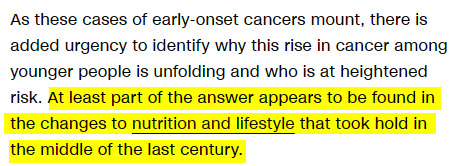
Now, I'm always dubious when reading anything that attributes a very broad generalized idea that changes in diets have caused an increased in cancer, because more often than not it's not pointing to an exploration of, say, increased pesticide use, but the author's personal bias against the quote unquote "unhealthy", especially those who are deemed "fat" by the medical industry.
That being said, I was curious what source he linked, half expecting it to lead to just another op-ed from some other doctor from who knows when, but I was pleasantly surprised! Written by a man named Michael Donaldson, it was an evidentiary review published in a scientific journal called "Nutrition and cancer: A review of the evidence for an anti-cancer diet."
Now I wasn't going to give the whole thing a read, but I stopped in each section, gave a quick skim to get a general vibe, moved on to the next section, etc. I was immediately suspicious that the very first line in the abstract was "It has been estimated that 30–40 percent of all cancers can be prevented by lifestyle and dietary measures alone" as that seems to be a bananas statistic to just posit, but it still had the air of scientific integrity, so I did my skim.
The first handful of sections had things that gave me some moments of pause, that this article was in fact another doctor simply cherry picking data to confirm his own biases, but nothing so egregious as to do a spit take. That comes in a few minutes. The first section that made really go hold the phone was when we got to his Flax Seed section.
Compare how he writes about Red Meat...:

(that's all he wrote, btw)
...with how he starts writing about Flax Seed:
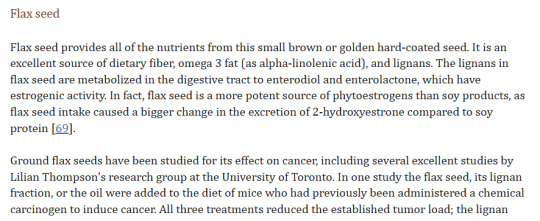
Did I just enter a Flax Seed commercial? Does this guy work for BIG FLAX SEED? on and on he writes about Flax Seed, and I start getting a sense that perhaps this man has a Flax Seed Agenda. In any case, he eventually moves on and I quickly skim to get to the end (because it's boring among other things).
So, who exactly is Michael Donaldson?


Girl are you kidding me
The Hallelujah Acres Foundation is a FOR PROFIT company that sells a """biblical""" based diet program called the hallelujah diet and also sells supplements on said site.
Now, in case you forgot where I started with this, this was the link provided as a "source" to a legitimate doctor's claim in an op-ed about cancer that "at least part of the answer" of why cancer is increasing in under 50 patients are the "changes to nutrition and lifestyle that took hold in middle of the last century." Dr. Baig did not read this article, or if he did was not concerned that it was written by the employee of a company that profits from unscientific research it uses to sell supplements and diets. Which is worse, I don't know.
The point I'm making is that you absolutely need to be vigilant all the time. You need to understand that doctors can not only have biases, but agendas. Researchers can have biases and agendas. Scientists can have biases and agendas. And that magical thinking about real health issues that can affect your future can permeate the scientific community because weirdos write convincing enough evidence that support their already determined world view.
This kind of shit is the reason why women go into doctor offices complaining about pain in their abdomen and get told to go lose weight and come back in 6 months. This is why ideas like moralizing eating have huge effects on women's health and influence medical misogyny, and why it's a feminist issue.
367 notes
·
View notes
Text
A notable diversity among the artisans was identified, as men, women, and children actively participated in making figurines, challenging the preconceived notion that this was an exclusively male craft." In other words archaeologists were stunned that women also worked in the family businesses and children were trained in the family business while still young. 🤦♀️
by Guillermo CarvajalJanuary 14, 2025

Example of a figurine (H20257) from Thonis-Heracleion with close-up of the fingerprints found on the reverse and interior. Credit: Franck Goddio / Hilti Foundation
An archaeological study published in the Oxford Journal of Archaeology by Leonie Hoff analyzes the fingerprints impressed on terracotta figurines found in the ancient city of Thonis-Heracleion in Egypt (located near Alexandria, with its ruins discovered 2.5 kilometers offshore and 10 meters underwater).
This analysis, which combines advanced technology with traditional archaeological methods, reveals who the artisans were that molded these pieces between the 7th and 2nd centuries BCE, offering unprecedented details about the organization of labor in ancient Egypt.
Thonis-Heracleion, a thriving Egyptian port located near the Nile’s mouth, flourished as a vital hub for trade and control between the Greek and Egyptian worlds. The city, founded in the 8th century BCE, became a cultural and economic center until its prominence was overshadowed by Alexandria. A natural disaster in the 2nd century BCE caused its collapse, and it remained hidden underwater until its rediscovery in the 1990s.

Map of the known sanctuaries and major finds at Thonis-Heracleion. Credit: Franck Goddio / IEASM
In this context, the terracotta figurines found at the site provide crucial clues about daily practices, cultural interactions, and the division of labor in a cosmopolitan community.
The study focuses on nine figurines selected from over 60 that show visible fingerprints. These impressions were analyzed using Reflectance Transformation Imaging (RTI), a method that measures the density and amplitude of epidermal ridge patterns in the fingerprints. These data, cross-referenced with modern studies of fingerprint density, enabled the estimation of the artisans’ sex and age.
The study highlights three key findings that redefine our understanding of artisanal production in ancient Thonis-Heracleion. First, a notable diversity among the artisans was identified, as men, women, and children actively participated in making figurines, challenging the preconceived notion that this was an exclusively male craft.

Silicone moulded copy of imprints found on the interior of H20257, including measurements taken for ridge breadths (lines) and ridge densities (squares). Credit: Franck Goddio / Hilti Foundation
Moreover, the fingerprints reveal a collaborative process in which children, likely apprentices, worked under the supervision of adults, pointing to the existence of a structured training system within the workshops. Lastly, a significant cultural impact was observed, evidenced by the adoption of Greek techniques, such as using molds and fine materials, which were integrated with local styles and characteristics to create unique products reflecting the fusion of both cultures.
The presence of children in the workshops suggests a family-based artisanal economy, while the inclusion of women indicates a more equitable division of labor than previously assumed.
Differences between imported and locally produced figurines reflect dynamic cultural interactions. Greek objects tend to be more sophisticated and associated with predominantly male labor, while local pieces show greater diversity in participation.
This pioneering study in the use of fingerprints to understand Mediterranean archaeology lays the groundwork for broader research. Fingerprint analysis at other sites could reveal similar patterns and deepen our understanding of artisanal work and social relations in the ancient world.
SOURCES
Hoff, L. (2024) Fingerprints on figurines from Thonis-Heracleion. Oxford Journal of Archaeology, 43: 399–418. doi.org/10.1111/ojoa.12308
#Oxford Journal of Archaeology#Leonie Hoff#ancient city of Thonis-Heracleion#Egypt#Reflectance Transformation Imaging (RTI)#Women have always worked
54 notes
·
View notes
Text
Space Station Concepts: Space Operations Center


"The SOC is a self-contained orbital facility built up of several Shuttle-launched modules. With resupply, on-orbit refurbish- ment and orbit maintenance, it is capable of continuous operation for an indefinite period. In the nominal operational mode, the SOC is manned continuously, but unmanned operation is possible.
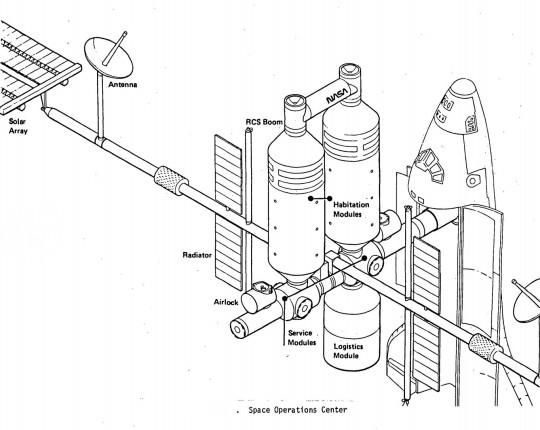
The present mission management and control process is characterized by a people-intensive ground monitoring and control operation involving large supporting ground information and control facilities and a highly- integrated ground-flight crew operation. In order to reduce dependence on Earth monitoring and control, the SOC would have to provide for increased systems monitoring; fault isolation and failure analysis, and the ability to store and call up extensive sets of data to support the onboard control of the vehicle; and the onboard capability for daily mission and other activity planning."



"Like most other space station studies from the mid/late 1970s its primary mission was the assembly and servicing of large spacecraft in Earth orbit -- not science. NASA/JSC signed a contract with Boeing in 1980 to further develop the design. Like most NASA space station plans, SOC would be assembled in orbit from modules launched on the Space Shuttle. The crew's tour of duty would have been 90 days. NASA originally estimated the total cost to be $2.7 billion, but the estimated cost had increased to $4.7 billion by 1981. SOC would have been operational by 1990.

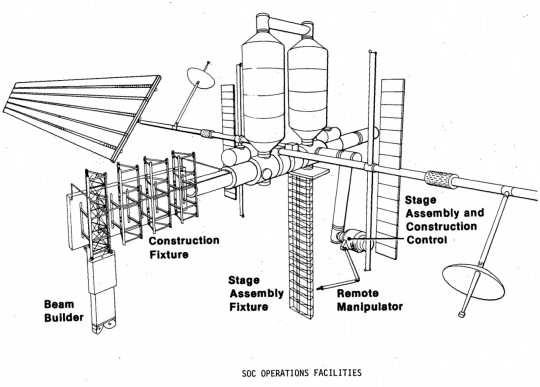

NASA's Johnson Spaceflight Center extended the Boeing contract in February 1982 to study a cheaper, modular, evolutionary approach to assembling the Space Operations Center. An initial power module would consist of solar arrays and radiators. The next launches would have delivered a space tug 'garage', two pressurized crew modules and a logistics module. The completed Space Operations Center also would have contained a satellite servicing and assembly facility and several laboratory modules. Even with this revised approach, however, the cost of the SOC program had grown to $9 billion. Another problem was Space Operations Center's primary mission: spacecraft assembly and servicing. The likely users (commercial satellite operators and telecommunications companies) were not really interested in the kind of large geostationary space platforms proposed by NASA. By 1983, the only enthusiastic users for NASA's space station plans were scientists working in the fields of microgravity research and life sciences. Their needs would dictate future space station design although NASA's 1984 station plans did incorporate a SOC-type spacecraft servicing facility as well."
Article by Marcus Lindroos, from astronautix.com: link




NASA ID: link, S79-10137
Boeing photo no. R-1859, link, link
#Space Operations Center#Space Station Freedom#Space Station Concept#Space Station#Concept Art#Space Station Program#Space#Earth#Space Shuttle#Orbiter#NASA#Space Shuttle Program#1979#1980s#my post
460 notes
·
View notes
Text
Nearly half a million Israelis have left the country since the outbreak of the Gaza conflict on Oct. 7, according to a local newspaper on Thursday.
The Population and Immigration Authority estimates that 370,000 people left Israel in the past two months, including 230,309 in October and 139,839 in November, Zman magazine said.
According to the magazine, approximately 600,000 Israelis traveled abroad for vacation before the outbreak of the Gaza war, while nearly 370,000 others departed after the conflict.
Nearly 301,982 Israelis returned to Israel in October and 194,016 in November.
“The figures show that the number of Israelis who left and did not return is estimated at around 470,000,” Zman said."
Therefore, there is a negative migration of about half a million people, and this does not include thousands of foreign workers, refugees, and diplomats who left the country,” it added.
Reduced immigration
The Israeli magazine said that the Gaza conflict has significantly reduced immigration to Israel.
According to data released by the Ministry of Aliyah and Integration, approximately 2,000 people immigrated to Israel between Oct. 7 and Nov. 29.“
This is equal to nearly 1,000 immigrants per month, compared to around 4,500 per month on average since the start of this year until the outbreak of the war, reflecting a decrease of more than 70%,” the newspaper said.
In the first weeks of the Gaza war, immigration to Israel nearly ceased, with only 1,096 immigrants arriving in Israel in October, Zman said.
According to a Al Mayadeen article about this same report, the number immigrants decreased from 20,000 in the first quarter of the year to 11,000 in the 3rd quarter.
The website emphasized that several Israeli media outlets misinterpreted the return of 300,000 Israelis to Palestine as a significant wave of migration, overlooking the fact that the majority of returnees came back solely from holiday vacations.
#yemen#jerusalem#tel aviv#current events#palestine#free palestine#gaza#free gaza#news on gaza#palestine news#news update#war news#war on gaza
329 notes
·
View notes
Text
#Vietnam Building Integrated Photovoltaics Market#Market Size#Market Share#Market Trends#Market Analysis#Industry Survey#Market Demand#Top Major Key Player#Market Estimate#Market Segments#Industry Data
0 notes
Text
#Ireland Building Integrated Photovoltaics Market#Market Size#Market Share#Market Trends#Market Analysis#Industry Survey#Market Demand#Top Major Key Player#Market Estimate#Market Segments#Industry Data
0 notes
Text
Reference saved in our archive
An excellent breakdown of the efficacy of covid vaccines in children with some haunting statistics included:
Finally, only 7.4% of children ages 5 to 17 years in our study had received an XBB vaccine by the end of April 2024, which is similar to California Department of Public Health estimates of 6% to 7% for this same age group and time period.
Even if we could actually vax our way out of the covid pandemic, there's nowhere near enough uptake to pretend like we can. Mask up. Clean the air. Take all the steps and precautions you can to help keep yourself and everyone around you safe and healthy.
Introduction Vaccine effectiveness of XBB messenger RNA COVID-19 vaccines against mild to severe outcomes has been shown for adults in multiple global settings.1-3 However, data describing the effectiveness of updated COVID-19 vaccines in children are scarce. We evaluated the BNT162b2 XBB vaccine (Pfizer-BioNTech) effectiveness in children ages 5 to 17 years during the 2023-2024 respiratory virus season in a large integrated US health system.
Methods Similar to prior studies,3 we conducted a test-negative case-control analysis to evaluate BNT162b2 XBB vaccine effectiveness against acute respiratory infection (ARI)-associated (eTable in Supplement 1) hospital admission and emergency department (ED) or urgent care visits among children ages 5 to 11 (using a 10-μg formulation) and 12 to 17 (30-μg formulation) years from October 10, 2023, through April 30, 2024, at Kaiser Permanente Southern California (KPSC). This study followed the Strengthening the Reporting of Observational Studies in Epidemiology (STROBE) reporting guidelines. This study was approved by the KPSC institutional review board with a waiver of informed consent because it involved a minimal risk to study participants.
Cases had a positive SARS-CoV-2 polymerase chain reaction (PCR) or antigen test during a hospital admission or ED or urgent care visit, and controls tested negative and had no evidence of a positive SARS-CoV-2 test in the prior 90 days. In sensitivity analyses, we evaluated the impact of (1) restricting results to PCR testing only, and (2) excluding test-negative controls identified by antigen testing alone. Odds ratios (ORs) and 95% CIs comparing the odds of vaccination with 1 or more doses of BNT162b2 XBB with the odds of not being vaccinated with any XBB vaccine were calculated from multivariable logistic regression models (eMethods in Supplement 1). Vaccine effectiveness was calculated as 1 − OR multiplied by 100%. Significance was determined with 95% CIs.
Results Of 15 233 ARI encounters among children ages 5 to 17 years meeting eligibility criteria (7342 female [48.2%]; 1450 Asian or Pacific Islander [9.5%], 1358 Black [8.9%], 8752 Hispanic [57.5%], 2678 White [17.6%]), 9834 were among 5-to-11-year–olds (334 hospital admissions [3.4%], 4377 ED visits [44.5%], and 5123 urgent care visits [52.1%]) and 5399 were among 12-to-17-year–olds (125 hospital admissions [2.3%], 1953 ED visits [36.2%], and 3321 urgent care visits [61.5%]) (eFigure in Supplement 1). Overall, 336 of 9834 5-to-11-year–olds (3.4%) and 388 of 5399 12-to-17-year–olds (7.2%) tested SARS-CoV-2 positive (Table 1). In the full cohort, 1125 children (7.4%) received an XBB vaccine by the end of April 2024; 339 of 9834 5-to-11-year–olds (3.4%) and 264 of 5399 12-to-17-year–olds (4.9%) received BNT162b2 XBB vaccine with median time since vaccination of 75 days (range, 15-199 days) and 64.5 days (range, 16-197 days), respectively. Among those ages 5 to 11 and 12 to 17 years, estimated adjusted BNT162b2 XBB vaccine effectiveness was 68% (95% CI, 11%-88%) and 63% (95% CI, 20%-83%) against COVID-19–associated hospital admission or ED or urgent care visits, respectively, with an overall estimated vaccine effectiveness for all 5-to-17-year–olds of 65% (95% CI, 36%-81%) (Table 2). No COVID-19–associated hospitalizations occurred among those who received BNT162b2 XBB vaccine. Estimated vaccine effectiveness was generally similar for all age groups if results were restricted only to PCR test results or if antigen results were used only to identify cases (Table 2).
Discussion Our results suggest that the BNT162b2 XBB vaccine provided protection against COVID-19–associated hospitalization and ED or urgent care visits among children 5 to 17 years of age during the 2023-2024 season with estimated vaccine effectiveness point estimates ranging from 63% to 73%. The US rate of COVID-19–associated hospitalization was roughly 10.5 per 100 000 among 5-to-17-year–olds from October 2023 through April 2024.4 Assuming 65% vaccine effectiveness, vaccinating the roughly 54.3 million 5-to-17-year–olds in the US5 could have averted approximately 3700 hospitalizations and, using the approximately 30:1 ratio of hospitalizations to ED or urgent care visits we observed in our study, roughly 111 000 ED or urgent care visits during the 2023-2024 respiratory virus season. Our observational design has previously described limitations,3 including potential unmeasured confounding, potential misclassification of prior infection or whether ARI encounters were truly COVID-19–related, and lack of generalizability to other populations. Finally, only 7.4% of children ages 5 to 17 years in our study had received an XBB vaccine by the end of April 2024, which is similar to California Department of Public Health estimates of 6% to 7% for this same age group and time period.6 More efforts are needed to improve pediatric COVID-19 vaccine uptake.
#mask up#public health#wear a mask#wear a respirator#pandemic#covid#still coviding#covid 19#coronavirus#sars cov 2
53 notes
·
View notes
Text
Soaring into Aerospace: NASA Interns Take Flight at EAA AirVenture Oshkosh

Sustainable Aviation Ambassadors Alex Kehler, Bianca Legeza-Narvaez, Evan Gotchel, and Janki Patel pose in front of the NASA Pavilion at EAA AirVenture Oshkosh.
It’s that time of year again–EAA AirVenture Oshkosh is underway!
Boasting more than 650,000 visitors annually, EAA AirVenture Oshkosh, or “Oshkosh” for short, is an airshow and fly-in held by the Experimental Aircraft Association (EAA). Each year, flight enthusiasts and professionals from around the world converge on Oshkosh, Wisconsin, to engage with industry-leading organizations and businesses and celebrate past, present, and future innovation in aviation.
This year, four NASA interns with the Electrified Powertrain Flight Demonstration (EPFD) project count themselves among those 650,000+ visitors, having the unique opportunity to get firsthand experience with all things aerospace at Oshkosh.
Alex Kehler, Bianca Legeza-Narvaez, Evan Gotchel, and Janki Patel are Sustainable Aviation Ambassadors supporting the EPFD project, which conducts tests of hybrid electric aircraft that use electric aircraft propulsion technologies to enable a new generation of electric-powered aircraft. The focus of Alex, Bianca, Evan, and Janki’s internships cover everything from strategic communications to engineering, and they typically do their work using a laptop. But at Oshkosh, they have a special, more hands-on task: data collection.
“At Oshkosh, I am doing some data collection to better estimate how we can be prepared in the future,” said Janki, an Aerospace Engineering major from the University of Michigan. “Coming to Oshkosh has been an amazing experience… I can walk around and see people passionate about the work they do.”

The NASA Pavilion at EAA AirVenture Oshkosh is full of interactive exhibits and activities for visitors to engage with. NASA Interns Alex, Bianca, Evan, and Janki are collecting data in the pavilion to help improve future exhibits at Oshkosh.
In addition to gathering data to help inform future NASA exhibits and activities at Oshkosh, the interns also have the opportunity to engage with visitors and share their passion for aviation with other aero enthusiasts. For Evan, who is receiving his Master's in Aerospace Engineering from the Georgia Institute of Technology, “being able to be here and talk with people who are both young and old who are interested in what the future of flight could be has been so incredible.”
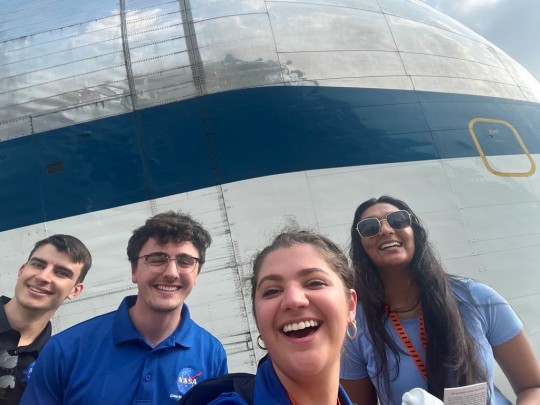
Alex, Evan, Bianca, and Janki pose in front of NASA’s Super Guppy, a specialized aircraft used to transport oversized cargo.
At Oshkosh, one memory in particular stands out for Alex, Bianca, Evan, and Janki: seeing NASA’s famous Super Guppy in person. With a unique hinged nose and a cargo area that's 25 feet in diameter and 111 feet long, the Super Guppy can carry oversized cargo that is impossible to transport with other cargo aircraft.
“We had a very lucky experience… We were able to not only see the Super Guppy, we got to get up close when it landed,” said Bianca, who is receiving her Master's in Business Administration with a specialization in Strategic Communications from Bowling Green State University. “From a learning experience, it gave me a way better basis on cargo aircraft and how they operate.”
For Alex, who is receiving his Master's in Aeronautical Engineering from the Georgia Institute of Technology, it was exciting to see the Super Guppy’s older technology integrated with newer technologies up close. “There have been a lot of good memories, but I think the best one was the Super Guppy. It was cool to see this combination of 60’s and 70’s technology with this upgraded plane.”

Evan and Janki pose for a photo while walking around EAA AirVenture Oshkosh.
With Oshkosh coming to a close this Sunday, July 30, Alex, Bianca, Evan, and Janki also reflected on advice they have for future NASA interns on how they can get the most out of their internship: be curious and explore, connect with people who work in the field you’re interested in, and don’t be afraid to ask questions.
Alex advises potential NASA interns to “dream big and shoot for your goals, and divide that up into steps… In the end it will work out.” For Bianca, being open and exploring is key: “take opportunities, even if it’s the complete opposite thing that you were intending to do.”

“Ask questions all the time,” said Evan. “Even outside the internship, always continue asking people about what they are knowledgeable on.” And Janki encourages future interns to “Follow your own path. Get the help of mentors, but still do your own thing.”
Visiting Oshkosh and want to see NASA science in action? Stop by the NASA Pavilion, located at Aviation Gateway Park, and see everything from interactive exhibits on sustainable aviation, Advanced Air Mobility, Quesst, and Artemis to STEM activities–and you may even meet NASA pilots, engineers, and astronauts! At Oshkosh, the sky’s the limit.
Interested in interning with NASA? Head over to NASA’s internship website to learn more about internship opportunities with NASA and find your place in (aero)space.
Make sure to follow us on Tumblr for your regular dose of space!
#aeronautics#NASA#aviation#airplane#internships#airventure#intern#work advice#advice#avgeek#aircraft
913 notes
·
View notes
Text
For four years, the Biden regime peddled a fairy tale of economic triumph, crowing about job booms while Americans drowned in skyrocketing costs and record debt.
Families juggled second jobs, raided savings, and racked up credit-card bills just to eat, all while the administration and its media lapdogs insisted the economy was thriving.
Now, the truth is out: the Labor Department admits hundreds of thousands of those hyped jobs were pure fiction, conjured to prop up Biden’s image before the 2024 election.
The numbers don’t lie, but the regime sure did.
Newly released data exposes the extent of these discrepancies, raising questions about the integrity of economic reporting under Joe Biden.
The Bureau of Labor Statistics recently revealed that job growth from March 2023 to March 2024 was overstated by 598,000 nonfarm payrolls, marking the largest revision since 2009.
Initial monthly reports boasted 2.9 million jobs were added during this period, but the BLS’s preliminary annual benchmark, derived from the more comprehensive Quarterly Census of Employment and Wages, slashed this to 2.3 million—a 30% drop.
This reduces the average monthly job gain to 173,500, significantly below the 242,000 initially claimed.
For July to September 2023, the BLS’s Business Employment Dynamics data reported a net loss of 1,000 private-sector jobs, contradicting the monthly reports of 399,000 jobs gained.
Similarly, from March to June 2023, monthly reports estimated 398,000 jobs added, while BED showed a loss of 163,000 private-sector jobs. This suggests a net loss of over 160,000 jobs in mid-2023, not the near-800,000 gain advertised.
21 notes
·
View notes